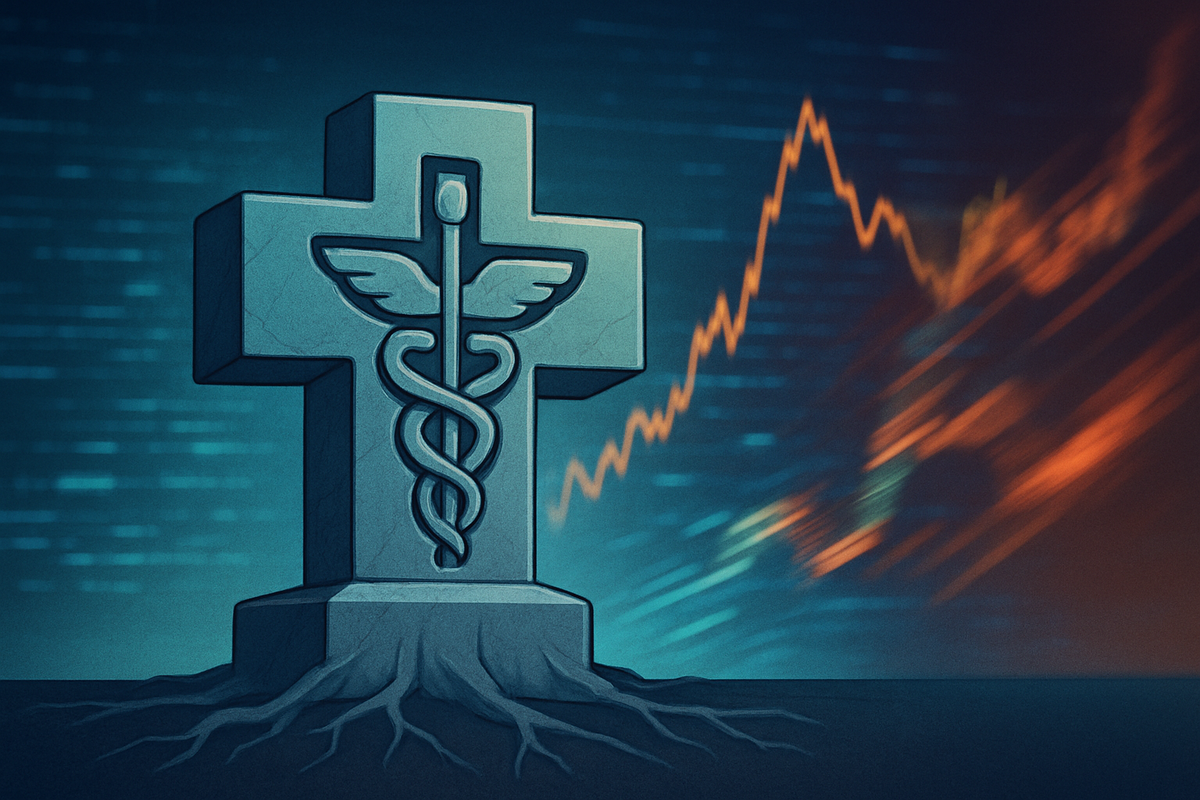
As the S&P 500 navigates a dynamic market on October 3, 2025, the Healthcare sector has emerged as a steadfast performer, demonstrating remarkable resilience and contributing significantly to the overall market's strength. This stability comes at a crucial time, as the technology sector experiences a notable pullback, leading investors to re-evaluate their portfolios and seek out more defensive plays. The consistent demand for healthcare services, coupled with ongoing innovation, continues to underscore the sector's non-cyclical nature, providing a crucial ballast to market volatility.
Today's market activity highlights a broader trend of investor rotation towards sectors traditionally considered stable during periods of economic uncertainty or when high-growth sectors face headwinds. The Healthcare sector's ability to maintain a steady course offers a compelling narrative of fundamental strength and investor confidence in its long-term prospects. This performance is not merely a fleeting moment but rather a reflection of inherent characteristics that position healthcare as a reliable anchor in a fluctuating market landscape.
A Deep Dive into Healthcare's Market Resilience
The steady performance of the S&P 500 Healthcare sector on October 3, 2025, is rooted in several fundamental factors. Unlike many other industries, the demand for healthcare products and services remains relatively inelastic, meaning it is less affected by economic cycles. Whether the economy is booming or contracting, individuals consistently require medical care, pharmaceuticals, and medical devices. This consistent demand translates into stable revenue streams for healthcare companies, making them attractive investments during times of broader market apprehension.
Historically, the healthcare sector has often served as a defensive play for investors. During periods when growth-oriented sectors, such as technology, experience corrections or pullbacks due to concerns over valuations, interest rates, or future growth prospects, capital frequently flows into sectors perceived as more stable. This rotation helps to cushion the overall market's decline, as the resilience of sectors like healthcare offsets losses elsewhere. The lower correlation of healthcare stocks with highly cyclical sectors further enhances their appeal as a safe haven.
Key players in the healthcare sector, including pharmaceutical giants like Johnson & Johnson (NYSE: JNJ), medical device manufacturers such as Medtronic (NYSE: MDT), and managed care organizations like UnitedHealth Group (NYSE: UNH), are benefiting from this sustained demand. Their robust business models, often characterized by strong intellectual property, extensive research and development pipelines, and established market positions, enable them to weather market storms more effectively. The sector also benefits from an aging global population, which continues to drive increased demand for healthcare services and innovative treatments, further solidifying its long-term growth trajectory.
Winners and Losers: Navigating the Sector's Impact
The sustained strength of the Healthcare sector naturally creates a clear distinction between potential winners and those facing challenges in the current market environment. Companies within the S&P 500 Healthcare sector are poised to be significant beneficiaries. Pharmaceutical companies, for instance, with diversified drug portfolios and strong pipelines for new treatments, stand to gain from consistent demand and the ability to command premium pricing for innovative therapies. Biotech firms focused on groundbreaking research and development, particularly in areas like oncology, rare diseases, and gene therapies, could see increased investor interest as capital seeks growth opportunities outside of the tech space.
Medical device manufacturers also stand to benefit from the sector's resilience. Companies producing essential surgical equipment, diagnostic tools, and implantable devices will likely experience stable sales driven by ongoing medical procedures and an aging population requiring more interventions. Managed care providers, like Anthem (NYSE: ANTM) and Humana (NYSE: HUM), are also well-positioned, as their business models are often less susceptible to economic fluctuations, providing essential health insurance services that are a constant need.
Conversely, companies heavily reliant on discretionary spending or those with less diversified product offerings might face challenges if the broader economic outlook remains uncertain. While the healthcare sector generally thrives, individual companies with significant debt burdens or those struggling with patent expirations and limited innovation could find it harder to attract investor capital. The current market dynamic emphasizes the importance of strong fundamentals and a clear path to sustainable profitability, even within a resilient sector.
Broader Significance and Market Implications
The steadfast performance of the Healthcare sector on October 3, 2025, is more than just a daily market anomaly; it represents a significant indicator of broader industry trends and investor sentiment. This event underscores the sector's role as a defensive bulwark, fitting into a larger pattern where investors rotate into essential services during periods of market uncertainty. It highlights the enduring nature of healthcare demand, which remains largely independent of economic cycles, making it a reliable haven when other sectors, particularly technology, experience volatility.
The potential ripple effects of this trend are considerable. For competitors within the healthcare space, this sustained performance can encourage further investment in research and development, as well as strategic mergers and acquisitions, to capitalize on the sector's robust outlook. Partners, such as healthcare technology providers or medical suppliers, may also see increased demand for their services as the core healthcare industry expands and innovates. Regulatory or policy implications could also emerge, as governments might prioritize stable and essential sectors like healthcare for continued support or targeted incentives, especially given the ongoing focus on public health and medical advancements.
Historically, similar patterns have been observed during past market downturns or periods of tech-led corrections. For example, during the dot-com bubble burst in the early 2000s, defensive sectors like healthcare provided stability amidst widespread market turmoil. This historical precedent reinforces the notion that healthcare's current performance is not an isolated incident but rather a testament to its inherent stability and its crucial role in balancing overall market portfolios.
What Comes Next: Navigating Future Horizons
Looking ahead, the sustained strength of the Healthcare sector presents both short-term and long-term possibilities for investors and companies alike. In the short term, we can anticipate continued investor interest in healthcare stocks as long as the technology sector faces headwinds or broader market uncertainty persists. This could lead to further capital inflows, potentially driving up valuations for fundamentally strong healthcare companies. Strategic pivots for some companies might involve accelerating innovation, exploring new market segments, or consolidating through M&A to strengthen their competitive positions and capitalize on this favorable environment.
In the long term, the underlying drivers of healthcare demand—an aging global population, advancements in medical science, and increasing chronic disease prevalence—are expected to remain potent. This suggests a continued trajectory of growth and resilience for the sector. Market opportunities may emerge in areas such as personalized medicine, digital health solutions, and biotechnology, as these sub-sectors are poised for significant expansion. Challenges, however, could include increasing regulatory scrutiny, pricing pressures, and the need for continuous innovation to stay competitive.
Potential scenarios and outcomes include a sustained period of outperformance for healthcare relative to more cyclical sectors, especially if global economic growth remains moderate. Alternatively, a significant rebound in the technology sector could see some capital rotate back, though healthcare's fundamental stability would likely prevent a sharp decline. Investors should watch for key developments in healthcare policy, new drug approvals, and M&A activity within the sector, as these will be crucial indicators of future performance and strategic direction.
Comprehensive Wrap-Up: A Resilient Future
In summary, the steady performance of the S&P 500 Healthcare sector on October 3, 2025, serves as a powerful testament to its inherent resilience and critical role in the broader market. Key takeaways from this event highlight healthcare's non-cyclical demand, its defensive characteristics during periods of market volatility, and the consistent innovation driving its growth. This stability has provided a crucial anchor for the overall market, particularly in light of the tech sector's recent pullback.
Moving forward, the market is likely to continue recognizing the value of defensive sectors like healthcare, especially as investors seek stability and consistent returns. The fundamental drivers underpinning the healthcare industry—demographic shifts, technological advancements, and persistent demand for essential services—are robust and enduring, suggesting a positive long-term outlook.
Investors should closely monitor several factors in the coming months. These include evolving healthcare policies, the pace of pharmaceutical and biotech innovation, and any significant shifts in M&A activity within the sector. Furthermore, observing how major healthcare companies manage pricing pressures and navigate regulatory landscapes will be crucial in assessing their continued performance. The Healthcare sector's ability to maintain its steady course underscores its significance as a cornerstone of the S&P 500, offering both stability and long-term growth potential in an ever-changing financial landscape.
This content is intended for informational purposes only and is not financial advice.





